Introducing a newly mated queen
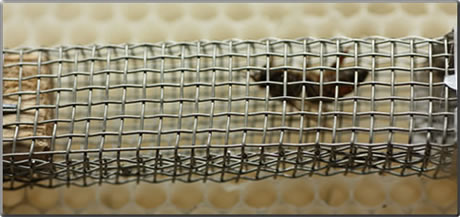
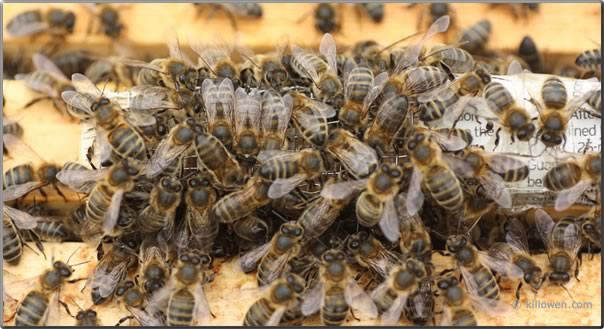
The first job is to release the queen, mark her and put her into a Butler cage (shown left). This cage is closed at one end with a small wooden block and at the other with a small piece of newspaper secured with an elastic band or Sellotape. A small tear is put into the paper to help the bees release the queen later on.
The Butler cage is now laid along the top of the middle frame. The newspaper end is protected from the bees by a -shaped piece of metal. The nuc is fitted with a Perspex crown board fitted with a rim so that the Perspex sits high enough to allow the bees access to the cage from above. The behaviour of the bees can now be easily observed without undue disturbance. The nuc entrance is opened 2 hours later. This delay allows the queen's pheromone to pervade the nuc and the small colony gains its unique identity.
-shaped piece of metal. The nuc is fitted with a Perspex crown board fitted with a rim so that the Perspex sits high enough to allow the bees access to the cage from above. The behaviour of the bees can now be easily observed without undue disturbance. The nuc entrance is opened 2 hours later. This delay allows the queen's pheromone to pervade the nuc and the small colony gains its unique identity.
On release the bees embark excitedly on orienteering flights and gradually become calmer. On one occasion two bees are observed returning to the nuc with pollen after only one hour.
The Butler cage is now laid along the top of the middle frame. The newspaper end is protected from the bees by a
On release the bees embark excitedly on orienteering flights and gradually become calmer. On one occasion two bees are observed returning to the nuc with pollen after only one hour.
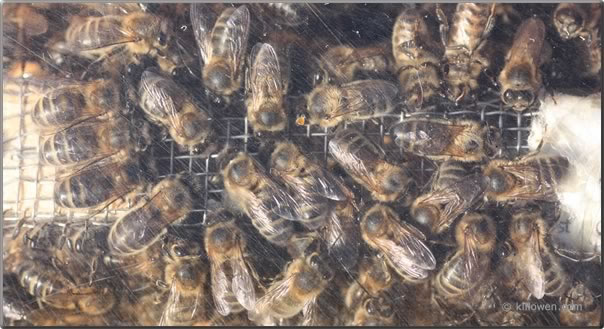
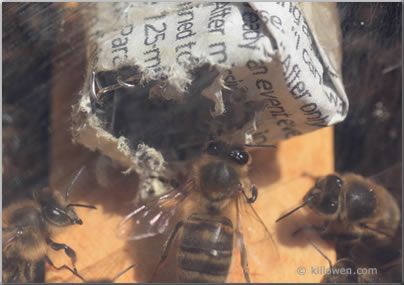
The photo shows the initial reaction to the new queen in the Butler cage after 1 hour.
There is a lot of initial excitement but the bees are perhaps showing too much interest for the queen to be immediately released.
This set up is left for a day to enable the bees to familiarize themselves with the queen. Sometimes there might be an initial aggression shown towards her so it is not advisable to allow the bees to release her immediately. This is apparent if the bees form a kind of rugby scrum over the cage and appear to be biting the wires (see photo left).
There is a lot of initial excitement but the bees are perhaps showing too much interest for the queen to be immediately released.
This set up is left for a day to enable the bees to familiarize themselves with the queen. Sometimes there might be an initial aggression shown towards her so it is not advisable to allow the bees to release her immediately. This is apparent if the bees form a kind of rugby scrum over the cage and appear to be biting the wires (see photo left).
In this photo taken through the Perspex screen the reaction of the bees is shown after 24 hours.
The bees are much more orderly and are quite calm forming a circle around the queen.
It would be safe to allow the bees to release her by biting through the paper.
The next day the cage is checked again to see if the bees are behaving normally and just attending to the queen. If this is the case (see photo left) then a magnet is used from above the Perspex to remove the metal piece so letting the bees tear away the newspaper.
The bees are much more orderly and are quite calm forming a circle around the queen.
It would be safe to allow the bees to release her by biting through the paper.
The next day the cage is checked again to see if the bees are behaving normally and just attending to the queen. If this is the case (see photo left) then a magnet is used from above the Perspex to remove the metal piece so letting the bees tear away the newspaper.
The photo on the left shows some bees eagerly awaiting the exit of the queen (or has she already escaped?). It took them 3 hours to tear away the newspaper.
When the queen is running free the Butler cage is removed and the Perspex crown board replaced with a normal one; the nuc is now left undisturbed for 2 weeks. After this time an inspection will show that the queen is laying up the two frames previous occupied by the emerging brood.
The nuc frames are now transferred to a brood box and more frames added as required. The small colony can now be fed with 2 kg sugar in a 2 : 1 syrup (dissolve 2 kg sugar in 1260 ml warm water). This will readily be taken down in about 3 days. The colony is allowed to build up over the summer.
It is advisable to monitor the colony for supersedure cells which the bees are inclined to build.
The newspaper method can be used later in the season to requeen another colony with this new queen.
When the queen is running free the Butler cage is removed and the Perspex crown board replaced with a normal one; the nuc is now left undisturbed for 2 weeks. After this time an inspection will show that the queen is laying up the two frames previous occupied by the emerging brood.
The nuc frames are now transferred to a brood box and more frames added as required. The small colony can now be fed with 2 kg sugar in a 2 : 1 syrup (dissolve 2 kg sugar in 1260 ml warm water). This will readily be taken down in about 3 days. The colony is allowed to build up over the summer.
It is advisable to monitor the colony for supersedure cells which the bees are inclined to build.
The newspaper method can be used later in the season to requeen another colony with this new queen.
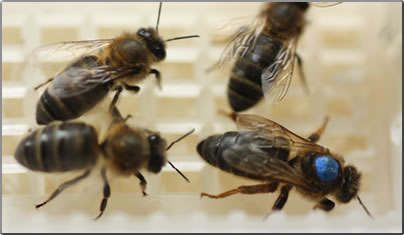
The new mated queen arrives
through the post in a traveling cage surrounded by 6 workers who not only have fed her on her journey but have provided packaging in what could have been a bumpy ride.
The introduction of this queen to a newly dequeened colony can be fraught with danger. There is no guarantee that this new queen will be accepted. A much safer alternative is to introduce the queen into a nuc containing only young bees and newly emerging ones. These latter having known no other queen will readily accept the new one.
The nuc is made up the day before the queen is due to arrive with the entrance closed. This allows the bees to settle down and realize they are queenless. The nuc consists of:
2 frames of sealed brood and the bees thereon
(on one of these frames the bees should be just emerging); and
3 frames of stores.
through the post in a traveling cage surrounded by 6 workers who not only have fed her on her journey but have provided packaging in what could have been a bumpy ride.
The introduction of this queen to a newly dequeened colony can be fraught with danger. There is no guarantee that this new queen will be accepted. A much safer alternative is to introduce the queen into a nuc containing only young bees and newly emerging ones. These latter having known no other queen will readily accept the new one.
The nuc is made up the day before the queen is due to arrive with the entrance closed. This allows the bees to settle down and realize they are queenless. The nuc consists of:
2 frames of sealed brood and the bees thereon
(on one of these frames the bees should be just emerging); and
3 frames of stores.